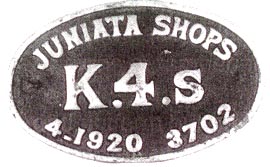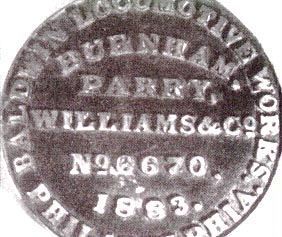Fake Builders and Number Plates
Builders plates are castings or sheet metal plates that are attached to locomotives and other rolling stock to indicate the manufacturer, date of production, manufacturing number, and other information. In the steam locomotive era, builders plates were usually made of cast brass or iron. Often when a locomotive was scrapped, the builders plate was removed and retained as a memento. Thus the builders plate may be the only surviving remnant of a particular locomotive.
Numbers plates are cast metal plates indicating the number of a locomotive and typically mounted on the front. Like builder's plates, these were often one of the few items salvaged from a scrapped locomotive.
In the railroadiana market, original builders and number plates are highly sought after and usually priced in the hundreds of dollars. Many reproductions have been made, and while these are usually represented in a responsible manner, there have also been reports of such reproductions being passed off as the real thing. Some reproductions are extremely well-done, so collectors should be wary.
In the mid-1980's a company called Railroad Replicas produced
a number of reproduction plates. While these were clearly
marketed as replicas, they may now be represented as originals
in the railroadiana market, either intentionally or unintentionally.
A brochure and list of products from this company are available
on a separate page: Fake Builders Plates
II.
Also a series of reproduction Norfolk & Western steam
locomotive plates have recently become known, although the plates
were made decades ago. See our page on Fake
N&W Plates.
Bill and Sue Knous have provided many of the following points to consider:
 Most reproductions appear to be aluminum, fiberglass, or bronze while the originals were either brass or cast iron. Most reproductions appear to be aluminum, fiberglass, or bronze while the originals were either brass or cast iron.
  A number of aluminum reproductions of Pennsylvania Railroad builders plates have been done. One of these is shown at right. Other PRR locomotives represented in this series of reproductions are the following classes: A3, A5s, B6sb, C1, D16a, D16sb, E6s, F1a, G5s, C1s, H9s, l1s, J1, K2, K4s, K5, L1 s, M1, Q2, S1 and T1. A number of aluminum reproductions of Pennsylvania Railroad builders plates have been done. One of these is shown at right. Other PRR locomotives represented in this series of reproductions are the following classes: A3, A5s, B6sb, C1, D16a, D16sb, E6s, F1a, G5s, C1s, H9s, l1s, J1, K2, K4s, K5, L1 s, M1, Q2, S1 and T1.
 In
the late 1960's, a company offered for public sale over 60 different,
full-size, builders plate reproductions. Made from either fiber
glass, aluminum or bronze, these plates were advertised as exact
duplicates. Plates offered included American Locomotive Company,
Brooks Works, Lima Locomotive Works, Westinghouse, B&O Capitol
Logo, and front locomotive plates for the K2a (PRR) and Y (N&W)
class locomotives. These may be the same plates shown in a later
catalog -- see Fake
Builders Plates II. In
the late 1960's, a company offered for public sale over 60 different,
full-size, builders plate reproductions. Made from either fiber
glass, aluminum or bronze, these plates were advertised as exact
duplicates. Plates offered included American Locomotive Company,
Brooks Works, Lima Locomotive Works, Westinghouse, B&O Capitol
Logo, and front locomotive plates for the K2a (PRR) and Y (N&W)
class locomotives. These may be the same plates shown in a later
catalog -- see Fake
Builders Plates II.
  Shown at right is a reproduction Baldwin Locomotive plate. The original and reproduction differ in the overall size and the depth of the lettering. Otherwise, distinguishing the two is very difficult. Collectors who are interested in builders plates are advised to attend railroadiana shows and examine original plates from reputable dealers in order to get a "feel" for the characteristics of authentic examples. Shown at right is a reproduction Baldwin Locomotive plate. The original and reproduction differ in the overall size and the depth of the lettering. Otherwise, distinguishing the two is very difficult. Collectors who are interested in builders plates are advised to attend railroadiana shows and examine original plates from reputable dealers in order to get a "feel" for the characteristics of authentic examples.
 One important method of distinguishing an authentic builders plate from a reproduction is to look for evidence of boiler scale. This is a buildup of rust and deposits that occurs on the back of a plate after years of being exposed to the elements and due to being mounted against the engine boiler. For this reason, collectors are strongly advised to *never* polish the back of a builders plate. Doing so will remove evidence of authenticity and likely decrease the value of the plate dramatically. One important method of distinguishing an authentic builders plate from a reproduction is to look for evidence of boiler scale. This is a buildup of rust and deposits that occurs on the back of a plate after years of being exposed to the elements and due to being mounted against the engine boiler. For this reason, collectors are strongly advised to *never* polish the back of a builders plate. Doing so will remove evidence of authenticity and likely decrease the value of the plate dramatically.
 Here are two additional fake plates. The first one even has "reproduction" cast on the back. The N1s plate is also believed to be a fake. The N1s designation refers to a class of well-known Pennsylvania Railroad locomotives. Here are two additional fake plates. The first one even has "reproduction" cast on the back. The N1s plate is also believed to be a fake. The N1s designation refers to a class of well-known Pennsylvania Railroad locomotives.
 |
 |
 |
 |
| Above. Front and back views of two number plates believed to be reproductions of Strasburg Railroad locomotive plates. There is also a #31 plate. The plates are made of aluminum. Note the lack of mounting holes and clean backs. Photos courtesy of Pam W. |
 Update 2016. A collector emailed us to say that he came across a reproduction plate listed on [a web auction site] in its original packaging with other available reproduction plates printed on the back of the package. The plate is marked on the back to indicate it is a reproduction, and upon request the seller provided a picture of the back of the package. Click on the thumbnail image at upper right for a bigger image. We thank Dave B. for the information and the seller for the image! Update 2016. A collector emailed us to say that he came across a reproduction plate listed on [a web auction site] in its original packaging with other available reproduction plates printed on the back of the package. The plate is marked on the back to indicate it is a reproduction, and upon request the seller provided a picture of the back of the package. Click on the thumbnail image at upper right for a bigger image. We thank Dave B. for the information and the seller for the image! |
 Update 2017. This reproduction GG1 builders plate was offered in a recent auction. According to plate expert Ron Muldowney, this plate was produced in the 1970's by a company that took an original cast iron plate and made castings out of aluminum then placed them in a wooden frame. While it is true that early GG1 plates were made of aluminum, Ron says the last run of these were of cast iron. Click on the image for a larger version. We thank DK for the information. Update 2017. This reproduction GG1 builders plate was offered in a recent auction. According to plate expert Ron Muldowney, this plate was produced in the 1970's by a company that took an original cast iron plate and made castings out of aluminum then placed them in a wooden frame. While it is true that early GG1 plates were made of aluminum, Ron says the last run of these were of cast iron. Click on the image for a larger version. We thank DK for the information. |
 Klamath Machine & Locomotive Plate Controversy. See separate page. Klamath Machine & Locomotive Plate Controversy. See separate page.
 Fake
Norfolk & Western Locomotive
Plates. See separate
page. Fake
Norfolk & Western Locomotive
Plates. See separate
page.
Comments or additional information are welcome. Email Us.
Special thanks to Bill and Sue Knous for permission to reproduce text and images from their book. Also a hearty thanks to the collectors who have helped to put some light on the Klamath Machine and Locomotive Works controversy. |